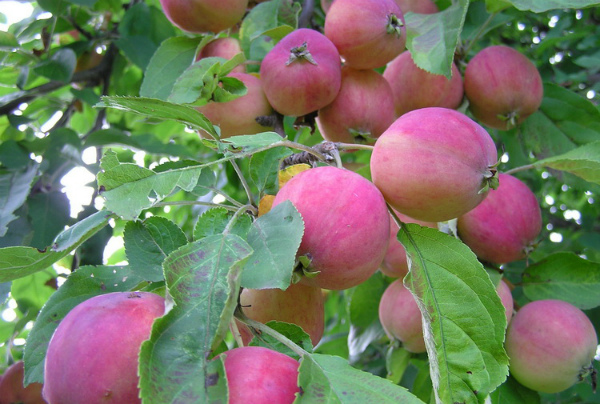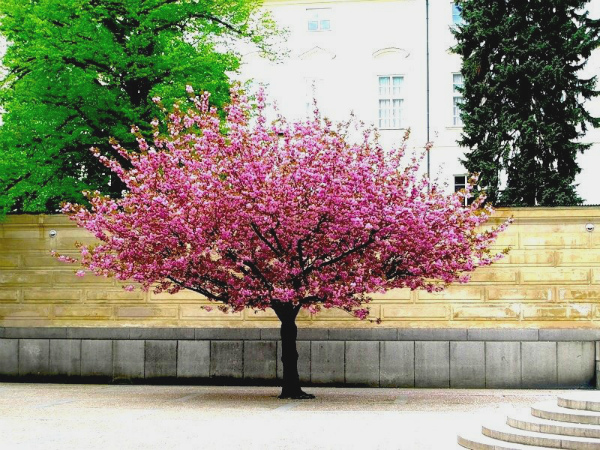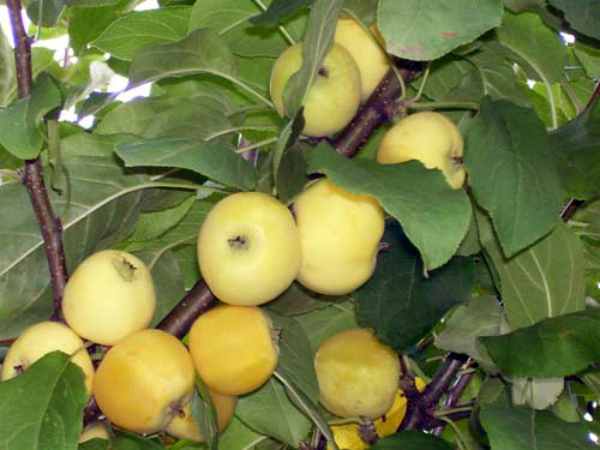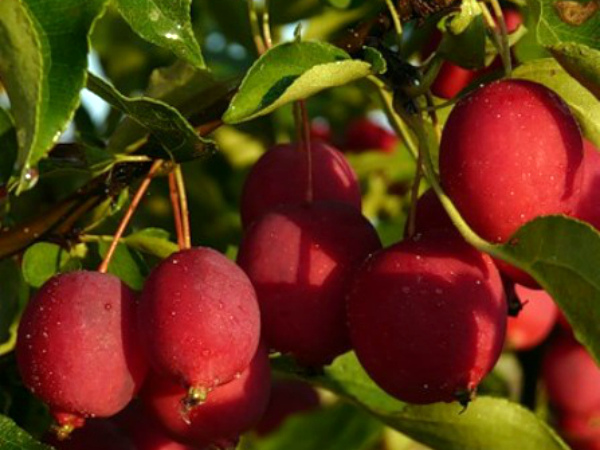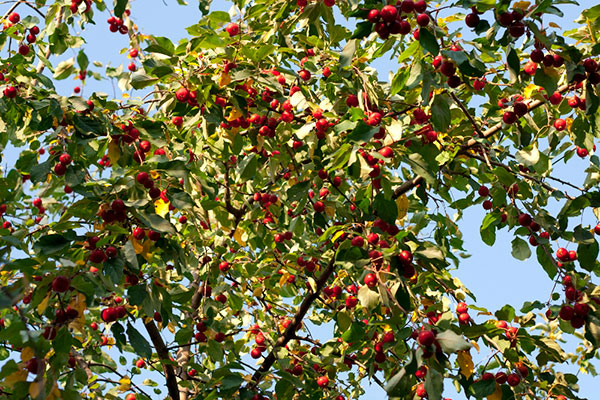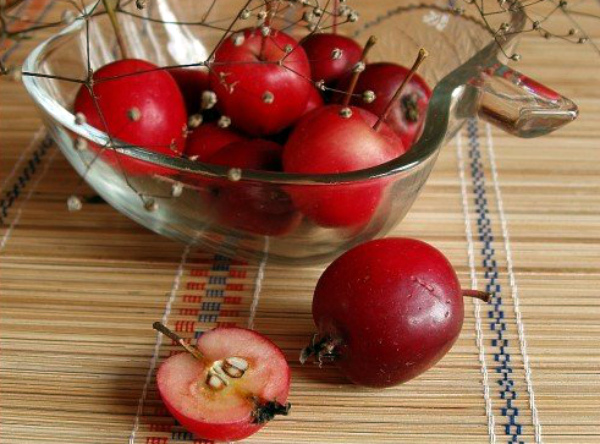Apple-tree Kitayka: an unusual variety in our gardens
Content
Description and characteristics of the variety
Strictly speaking, "Kitayka" is not a variety, rather, a species that unites numerous varieties that were bred by crossing garden apple trees with berry apple trees, in particular with "Sibirka". These are the varieties: "Kitaika anisovaya", "Kitaika golden early", "Kitaika dessertnaya", which were once bred by IV Michurin. This type includes "Kitayka Saninskaya" with small sour fruits and "Kitayka apricot", which in the Chelyabinsk region brings up to 100 kg of fruits from a tree with an average weight of 50 to 60 g. Among the popular are the following: "Kerr", " Long "," Belfleur ".
This plum apple tree got its nickname not because of its distribution in China and not because of its Chinese origin, it is just that its leaves are very similar to the leaves of the Chinese plum. They are long with pointed tops, with small serrations along the edge, glossy dark green in color. The trees grow large, up to 10 meters. Branches striving upward depart from the trunk at sharp angles and form a wide conical crown in an adult tree.
In the spring, the trees are covered in lush bloom. Flowers can be of different colors depending on the variety, they are no more than 3 cm in diameter, collected by an umbrella, give the world around you a sweet fragrance. Thanks to this aroma, there are always a lot of pollinating insects near the "Kitae", which fly to other flowering plants. Such a tree in the garden can increase the yield of varietal apples growing nearby, thanks to cross-pollination and the attraction of insects.
The roots of the apple tree are not very deep, but the root system is branched and powerful, it finds the necessary nutrients. These trees are completely undemanding to the composition of the soil, perfectly tolerate frosty winters, indifferent to droughts, immune to fungal diseases, "Kitayki" grow well in the harsh Siberia and in the north of the western part of the country.
"Belfer" is perhaps the only one of these varieties that gives large fruits, oval light yellow with a bright red blush. They have a sweet and sour taste and a spicy aroma. Apples can reach from 120 g to 300 g. But this variety does not withstand cold winters, it is distributed only in the southern regions, and often suffers from scab.
"Kitayki" and "Ranetki" were specially bred by breeders for regions with harsh winters, it was not for nothing that they took "Sibirka" as material for their selection. But it turned out that only varieties with small fruits - 3 or 4 centimeters in diameter - are not afraid of cold weather, and large-fruited ones still cannot tolerate severe frosts.
The Canadian variety "Kerr" has been successfully cultivated for a long time in the Moscow region. The tree is not large, its crown is rare, it does not require mandatory pruning. Begins to bear fruit from the 3rd or 4th year, gives large yields, but alternates between abundant and moderate. Kerr is famous for its fruits with a high content of vitamin C. Red apples, reaching 40 g, are harvested in September.If you put them in storage in a cool place, then they are completely preserved until mid-winter. Canadians love to decorate the Christmas tree with them and stuff a bird for Christmas dinner. Kerr apples have a pleasant sour-sweet taste, but they are rarely eaten fresh, more often they make amazing desserts - marmalades, jellies, preserves, compotes, juices, cider.
"Early Golden Kitayka" looks quite different. The tree has a rare pyramidal crown. Fruiting begins as early as the 3rd year after planting. The variety is perfectly cultivated in the Volgo-Vyatka and North-West regions. Harvested in mid-August, small round, indeed, golden apples look like they are completely made of sunlight. The dense creamy pulp of the "Kitaika Golden Early" fruit has a delicate sweet and sour taste. They can be stored fresh for no more than one and a half weeks, so almost immediately after harvesting it is allowed to be processed.
The apple tree "Long" is striking in its decorativeness - a round wide crown in early autumn is simply covered with red small apples. The tree rarely grows above 4 meters, the fruits barely reach 20 g, red cone-shaped apples have a pleasant aroma and sweet and sour taste.
Growing features
"Kitayki" are drought-resistant, frost-hardy, undemanding in relation to the soil, but grow and bear fruit much better if they are provided with good conditions.
They love fertile light non-acidic soils, moderate moisture, respond well to feeding. It is better to plant them immediately in a permanent place. Only very young seedlings, two or three years old, can tolerate transplanting; older trees may not take root. They will survive in a shaded area, but will grow better in the sun.
Sour, heavy soils and a high level of groundwater will not kill such a persistent apple tree, but they will not allow it to grow into that decorative beauty that can become a decoration of the site, regardless of the taste of its spectacular fruits.
The cherry apple tree is often used as a rootstock for grafting, but it should be remembered that not all varieties can be combined with it, tissue rejection is possible.
Care
All apple trees are looked after in the same way - they water, fertilize, cut. "Kitayki" love watering, but do not allow stagnation of water. Mulching with sawdust, manure, or tree bark will help retain moisture. Under the trees, you need to remove plant debris, dig up the ground.
Every spring it is necessary to carry out sanitary pruning, and in the fall to form the crown. But during the summer, it is advisable to carefully monitor the branches, to prevent injuries and wounds, if such happen, then you need to immediately process them with garden varnish. Some trees grow in such a way that the branches form large forks. This should not be allowed, because under the weight of snow in winter or fruits in autumn, branches can break.
In the spring, the trunks are whitewashed to avoid sunburn.
Apple trees can be threatened by common pests: aphids, flies, apple moth. A solution of tobacco and soap helps with aphids, with which leaves and branches are abundantly washed. The bean leaf does not tolerate tobacco smoke, so it is easy to drive it away by fumigation. And the apple moth or apple blossom beetle will be defeated by the use of chlorophos.
Typically, apple trees are resistant to most diseases, but cytosporosis can damage them. It is best to deal with it with the preparation "Hom", it is used before bud break, or before flowering the tree is sprayed with copper sulfate.
Collection and storage
Fruits of different varieties ripen from August to late September. They are usually cut off, because the apples hold tightly to the small stalks. Fruits of most varieties are stored very little. The "Kerr" apples can be considered the record holder, which under appropriate conditions can lie until January. If you find a dark and cold place, then "Long" apples can be stored there for up to two months.Most fruits need to be consumed or processed in a week.
It is believed that all of the most beneficial elements in apples are found in the skin and immediately below it. From this point of view, the fruits of "Kitaek" contain only this layer with a high concentration of nutrients. Most of the fruits, indeed, contain a huge amount of ascorbic acid, sugars and trace elements useful for the body. They are very often used for the preparation of candied fruits, marmalades, wines, compotes. Gourmet jam or caramelized fruits can be the highlight of a sweet table. Adding apples to meat or fish dishes gives them an original taste and aroma.
Video "Apple-Chinese"
We bring to your attention a short overview of two ornamental fruit varieties of Chinese apple trees.

